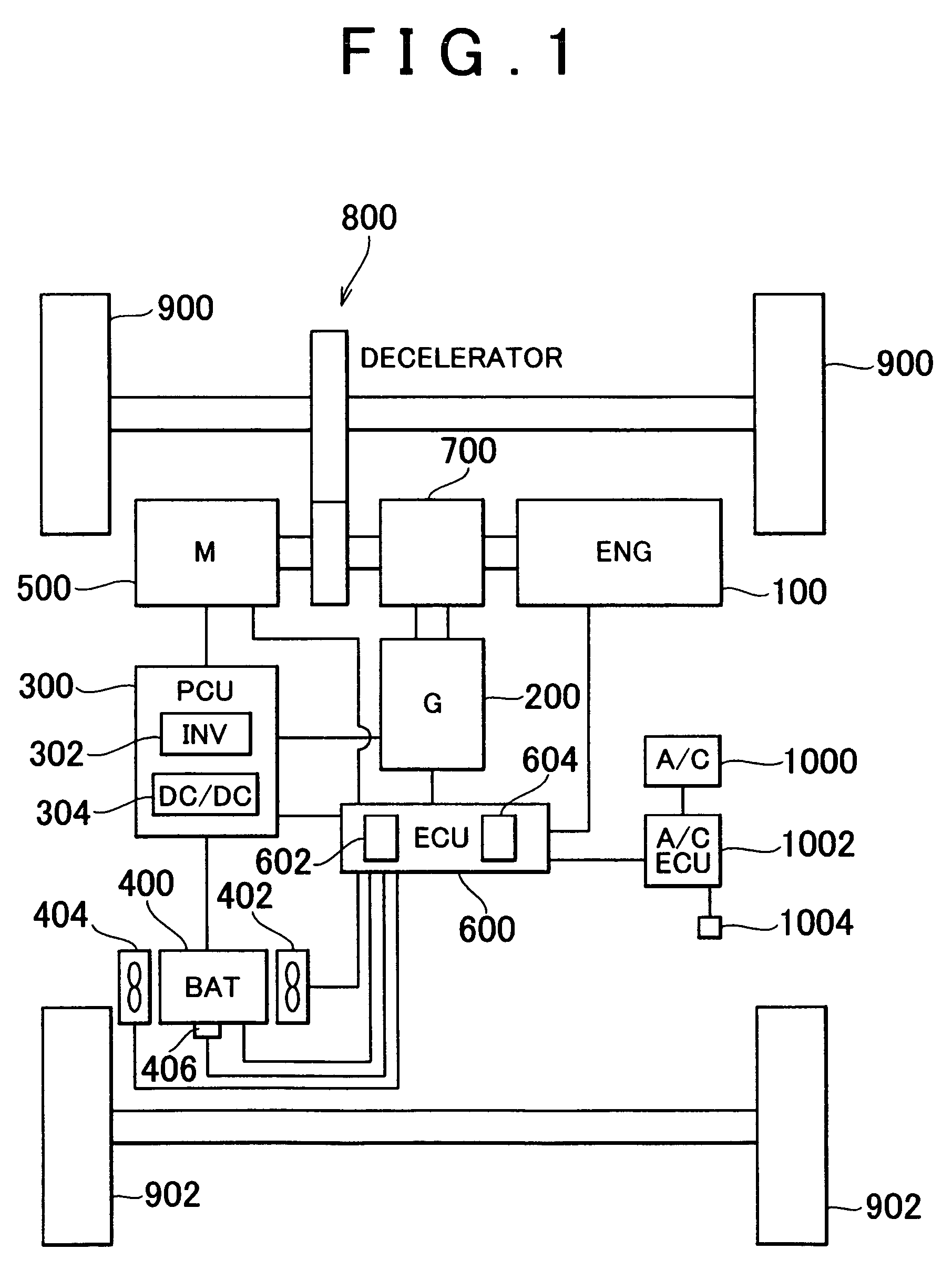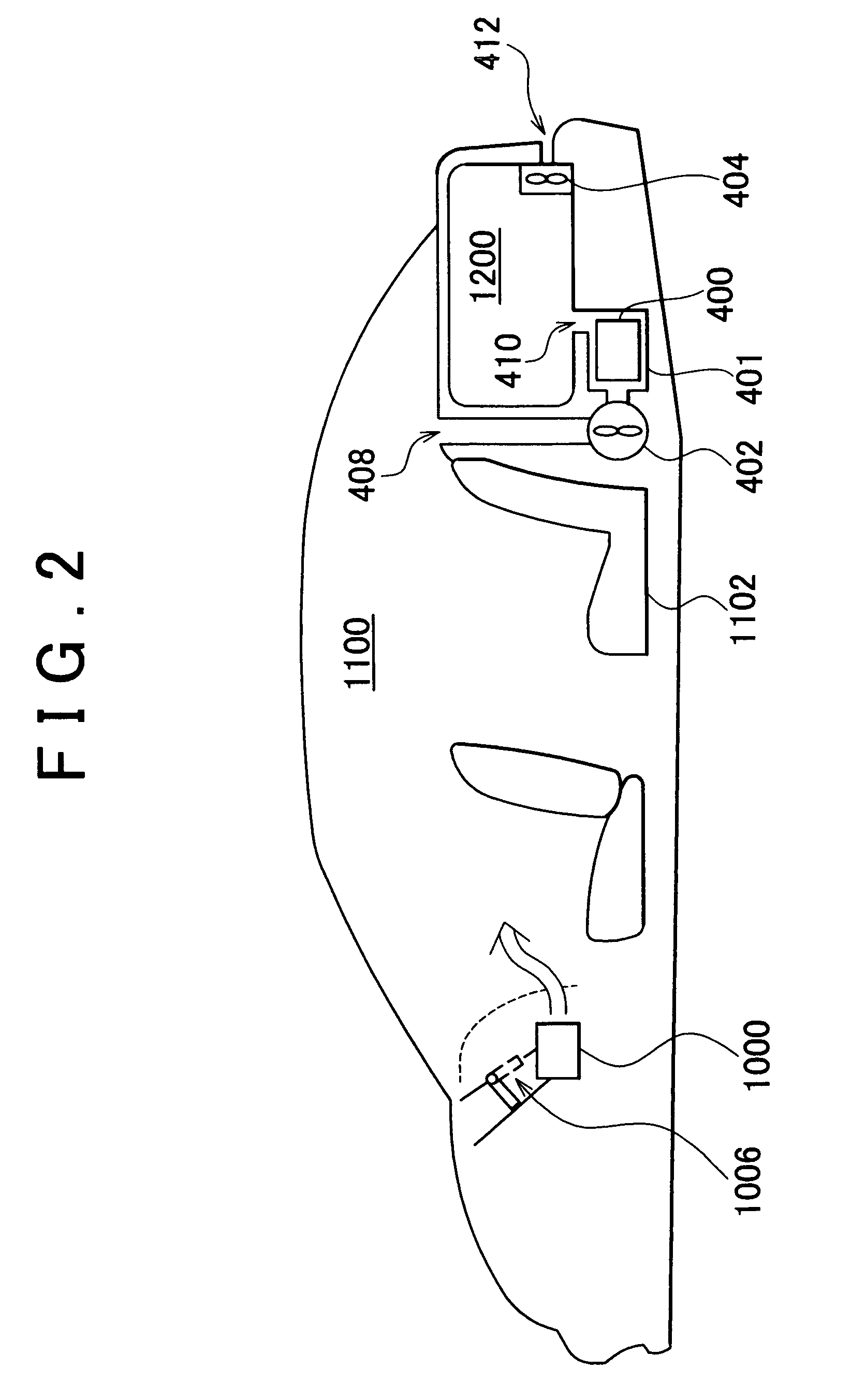Cooling system for power storage mechanism, cooling method of the same, and vehicle
a technology of power storage mechanism and cooling system, which is applied in refrigeration machines, propulsion using engine-driven generators, refrigeration components, etc., can solve the problems of reducing the space of the cabin compartment or the luggage compartment, requiring a space for the exhaust duct, and deteriorating the cooling performan
- Summary
- Abstract
- Description
- Claims
- Application Information
AI Technical Summary
Benefits of technology
Problems solved by technology
Method used
Image
Examples
first embodiment
[0031]Referring to FIG. 1, a vehicle equipped with a cooling system of a first embodiment according to the invention will be described. The vehicle is equipped with an engine 100, a generator 200, a PCU (Power Control Unit) 300, a battery 400, a motor 500, a hybrid ECU (Electronic Control Unit) 600 connected to all the aforementioned units, an air conditioning (hereinafter referred to as an A / C) unit 1000, and an A / C ECU 1002 connected to the A / C unit 1000.
[0032]The vehicle in this embodiment is a hybrid vehicle equipped with the engine 100. However, the vehicle according to the invention is not limited to the hybrid vehicle equipped with the engine 100. The invention may be applied to a hybrid vehicle equipped with a fuel cell (fuel cell vehicle) instead of the engine 100 or an electric vehicle equipped with a battery 400 only.
[0033]The power generated by the engine 100 is divided into two channels by a power transfer 700, one channel for driving wheels 900 via a decelerator 800, a...
second embodiment
[0058]A second embodiment of the invention will be described referring to FIG. 6. In the first embodiment, the cooling system is employed in the vehicle of sedan type including two sections, that is, cabin compartment and a luggage compartment. In this embodiment, the cooling system is employed in the vehicle of wagon (hatch-back) type in which the cabin compartment and the luggage compartment are not sectioned. Other characteristics such as hardware and control routine are the same as those in the first embodiment. The explanation of those characteristics in detail, thus will not be repeatedly described.
[0059]Referring to FIG. 6, the vehicle includes a cabin compartment 1110 and a luggage compartment 1210 that are connected with each other. The cabin compartment 1110 is parted from the luggage compartment 1210 with a tonneau cover 1212. The element that parts between the cabin compartment 1110 and the luggage compartment 1210 is not limited to the tonneau cover 1212, but may be a t...
third embodiment
[0060]A third embodiment of the invention will be described referring to FIG. 7. In the first embodiment, the cooling system is employed in the vehicle of sedan type including two sections, that is, a cabin compartment and a luggage compartment. In this embodiment, the cooling system is employed in the vehicle of mini van type in which the cabin compartment and the luggage compartment are not sectioned. Other characteristics such as hardware and control routine are the same as those in the first embodiment. The explanation of those characteristics in detail, thus will not be repeatedly described.
[0061]As shown in FIG. 7, the vehicle includes a cabin compartment 1120 and a third seat 1122 provided at a rear of the compartment 1120. An inlet 416 is formed at a position downward of the third seat 1122. An outlet 410 is formed at a position to the rear of the third seat 1122. The cooling air at the temperature increased by the heat transfer with the battery 400 is released rearward of t...
PUM
| Property | Measurement | Unit |
|---|---|---|
| volume | aaaaa | aaaaa |
| heat | aaaaa | aaaaa |
| size | aaaaa | aaaaa |
Abstract
Description
Claims
Application Information
 Login to View More
Login to View More - R&D
- Intellectual Property
- Life Sciences
- Materials
- Tech Scout
- Unparalleled Data Quality
- Higher Quality Content
- 60% Fewer Hallucinations
Browse by: Latest US Patents, China's latest patents, Technical Efficacy Thesaurus, Application Domain, Technology Topic, Popular Technical Reports.
© 2025 PatSnap. All rights reserved.Legal|Privacy policy|Modern Slavery Act Transparency Statement|Sitemap|About US| Contact US: help@patsnap.com



